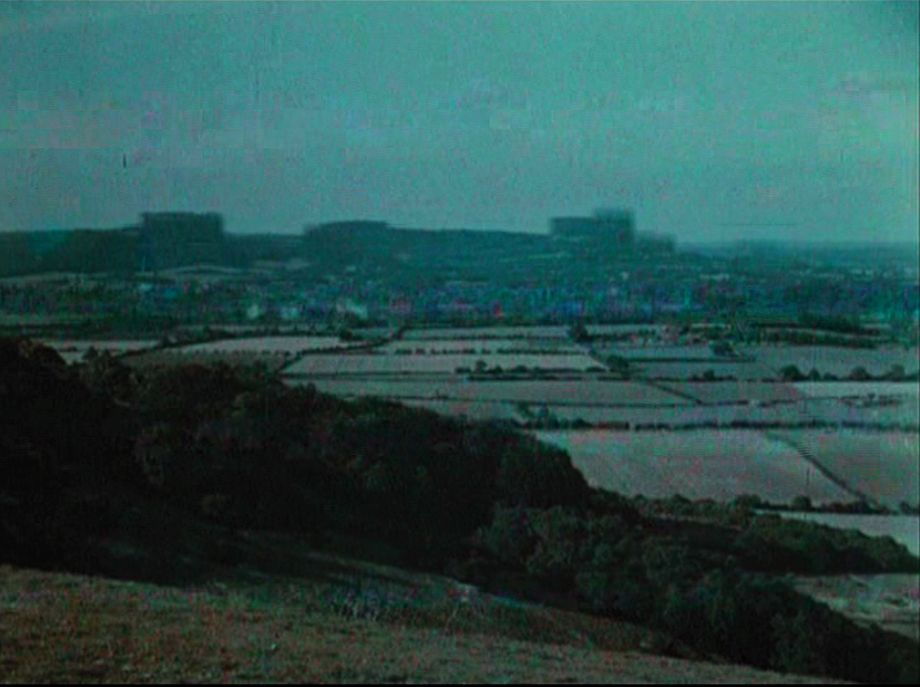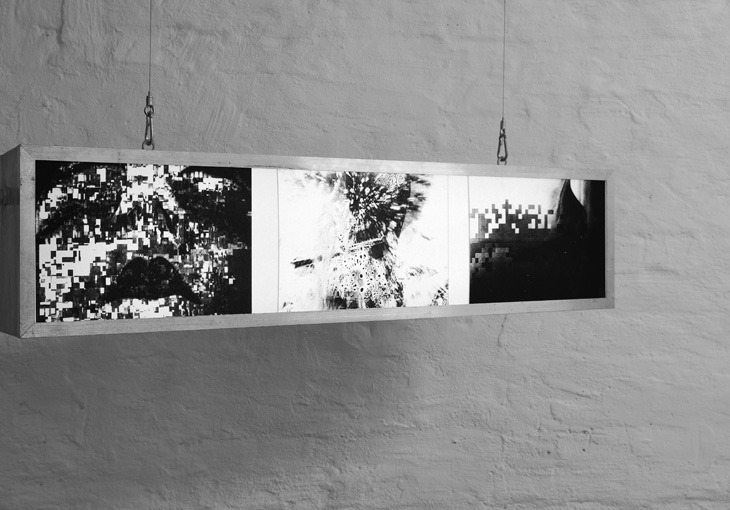

distortion | distortion series
Found Footage, HD Video 4:3, 4’40”, Colour and B&W, Stereo, Sound: Billy Roisz, supported by bundeskanzleramt österreich & wienkultur, distributed by sixpackfilm & Lydia Nsiah, art collection Wien Museum, 2016 | Serigraphy-Series (Print by Katharina Trieb, B&W), 2015; Images above: frame grab of ‘distortion’ by Lydia Nsiah, installation shot by Thomas Ries of Serigraphy Light Box, Pinacoteca Vienna (AT)
***
“In 1949, Hans Richter retrospectively cited distortion as an essential element in the quiver of the historical film avant-garde. Commercial film production failed to express an interest in such effects. “None of these ´poetic alienation processes´ were under patent; but the film industry still didn´t touch them.” (1) In distortion image distortion returns brilliantly, and does so as a commercial copyright instrument, of all things. The material bases of the video are DVD compilations of (largely canonical) experimental, ephemeral, and animation films. When these films are duplicated, their copy protection encoding generates digital artifacts, which now either — depending on the angle — soberly mutilate pictorial inventions by Duchamp, Léger, and Lye, or transform them in a second-order deformation: lips slip, color errors flash, surfaces shimmer, a buffalo nebulizes.
The videos inner dramatic composition leads from sheer abstraction (blobs vs. pixel drift) to concreteness of face, body, landscape, over which stretches the independent digital life of a wafting second skin. In everyday video file consumption interference signals normally point out corrupt data or overtaxed computers, here they move Nsiah´s rhythmic montage and Billy Roisz´s finely modulated soundtrack (distilled from the visual material) back into the avant-garde lab. There, the play with excessive demands is a questioning of what is given (media-technically as well as perceptually) and designing what is new. The gesture obtains its cunning irony in that it is precisely works of the film avant-garde that lose their instrumental working base (16-24 individual frames per second) on DVD. The final shot of distortion, a landscape image, reveals the change to digital motion picture processing as a shift of the horizon.” (Joachim Schätz)
(1) Hans Richter: The Avant-Garde Film Seen from Within. – In: Hollywood Quarterly, Heft 4, Herbst 1949. p. 37.
***
“The concepts of manipulation of images associated with their distortion and disintegration were, from a very early stage, developed by the experimental cinema and artistic avant-gardes. In the case of cinema, the processes leading to this distortion are different, from the action of time on the film to the chemical or physical processes, as well as the effects caused by the montage, overlapping of images or others. “Distortion” is included in this genealogy of experimental cinema, but in this case, it uses the aesthetic potential of digital coding for the protection against the reproduction of films: by copying the encoded moving images, they are transfigured into strange patterns as well as into distorted or imperceptible shapes. For this purpose, Lydia Nsiah used DVD-encoded compilations of historical experimental films (Duchamp, Léger, Len Lye), thus creating a second-hand deformation. Beyond the visual result, Nsiah reflects on the fact that, for the first time in the history of cinema, distortion, rarely or never assimilated by the mainstream cinema, is portrayed as a commercial tool (of copyright protection), and not as an artistic creation process.” (MD, Curtas Vila do Conde)
***
“Interference signals on all tracks: booming, choppy sound. The image disintegrates into digital blocks, into patterns and grids; flickers and vibrates. Flashing in between is a figure, a landscape, and a face. An uncanny rush of image and sound that probes the aesthetic potential of digitally deformed film. The concrete disintegrates into the abstract — distorted film in its most beautiful form.” (Michelle Koch, Diagonale’16 Catalogue)
***
“Es ist ein großer Coup filmemacherischer Subversion, jene Elemente ästhetisch zu verarbeiten, die dafür konzipiert sind das Filmerlebnis zu beeinträchtigen, denn Nsiah hat als Ausgangsmaterial Filmausschnitte gewählt, die durch digitale Kopierschutzmaßnahmen beeinträchtigt worden sind. Doch distortion ist weit mehr als nur Konzeptkunst, denn der Film funktioniert auch auf einer ästhetischen Erfahrungsebene: das Flackern der digitalen Partikel, die verzerrten Farben und verpixelten Flächen machen die ästhetischen Qualitäten eines Seherlebnisses deutlich, das sonst meist mit dem Frust über technisches Versagen verbunden ist.” (Rainer Kienböck, Jugend ohne Film)